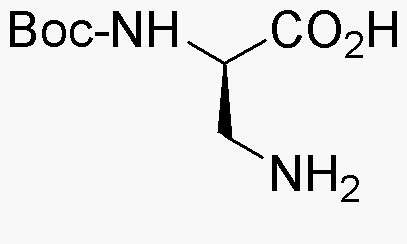Na-Boc-D-2,3-diaminopropionic acid is widely utilized in research focused on:
- Peptide Synthesis: This compound serves as a key building block in the synthesis of peptides, particularly in the development of pharmaceuticals and biologically active compounds.
- Drug Development: Its unique structure allows for modifications that can enhance the efficacy and stability of drug candidates, making it valuable in the pharmaceutical industry.
- Bioconjugation: The compound is used in bioconjugation techniques, which are essential for creating targeted drug delivery systems, improving therapeutic outcomes.
- Research in Neuroscience: It plays a role in studies related to neurotransmitter systems, aiding researchers in understanding neurological functions and disorders.
- Protein Engineering: This chemical is utilized in the modification of proteins, allowing scientists to alter their properties for various applications in biotechnology and medicine.
General Information
Properties
Safety and Regulations
Applications
Na-Boc-D-2,3-diaminopropionic acid is widely utilized in research focused on:
- Peptide Synthesis: This compound serves as a key building block in the synthesis of peptides, particularly in the development of pharmaceuticals and biologically active compounds.
- Drug Development: Its unique structure allows for modifications that can enhance the efficacy and stability of drug candidates, making it valuable in the pharmaceutical industry.
- Bioconjugation: The compound is used in bioconjugation techniques, which are essential for creating targeted drug delivery systems, improving therapeutic outcomes.
- Research in Neuroscience: It plays a role in studies related to neurotransmitter systems, aiding researchers in understanding neurological functions and disorders.
- Protein Engineering: This chemical is utilized in the modification of proteins, allowing scientists to alter their properties for various applications in biotechnology and medicine.
Documents
Safety Data Sheets (SDS)
The SDS provides comprehensive safety information on handling, storage, and disposal of the product.
Product Specification (PS)
The PS provides a comprehensive breakdown of the product’s properties, including chemical composition, physical state, purity, and storage requirements. It also details acceptable quality ranges and the product's intended applications.
Certificates of Analysis (COA)
Search for Certificates of Analysis (COA) by entering the products Lot Number. Lot and Batch Numbers can be found on a product’s label following the words ‘Lot’ or ‘Batch’.
*Catalog Number
*Lot Number
Certificates Of Origin (COO)
This COO confirms the country where the product was manufactured, and also details the materials and components used in it and whether it is derived from natural, synthetic, or other specific sources. This certificate may be required for customs, trade, and regulatory compliance.
*Catalog Number
*Lot Number
Safety Data Sheets (SDS)
The SDS provides comprehensive safety information on handling, storage, and disposal of the product.
DownloadProduct Specification (PS)
The PS provides a comprehensive breakdown of the product’s properties, including chemical composition, physical state, purity, and storage requirements. It also details acceptable quality ranges and the product's intended applications.
DownloadCertificates of Analysis (COA)
Search for Certificates of Analysis (COA) by entering the products Lot Number. Lot and Batch Numbers can be found on a product’s label following the words ‘Lot’ or ‘Batch’.
*Catalog Number
*Lot Number
Certificates Of Origin (COO)
This COO confirms the country where the product was manufactured, and also details the materials and components used in it and whether it is derived from natural, synthetic, or other specific sources. This certificate may be required for customs, trade, and regulatory compliance.


